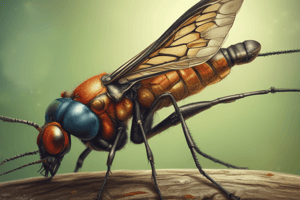Podcast
Questions and Answers
Which is not a purpose of the hissing sound produced by Madagascar hissing cockroaches?
Which is not a purpose of the hissing sound produced by Madagascar hissing cockroaches?
- To attract a mate
- To attract prey (correct)
- To establish dominance
- To scare away predators
Where are the compound eyes of insects typically located?
Where are the compound eyes of insects typically located?
- Head (correct)
- Abdomen
- Thorax
- Legs
Which body region of insects houses the wings and legs?
Which body region of insects houses the wings and legs?
- Head
- Thorax (correct)
- Abdomen
- Antennae
What is the function of spiracles in insects?
What is the function of spiracles in insects?
What specialized pads on the feet of Madagascar hissing cockroaches allow them to do?
What specialized pads on the feet of Madagascar hissing cockroaches allow them to do?
Flashcards are hidden until you start studying
Study Notes
Insects: Behavior, Anatomy, and the Madagascar Hissing Cockroach
Insects are a diverse group of organisms that play a vital role in various ecosystems. They exhibit unique behaviors and anatomy that enable them to thrive in their environment. One such insect is the Madagascar hissing cockroach, Gromphadorhina portentosa, a species native to Madagascar.
Insect Behavior
Insects exhibit a wide range of behaviors, including social, defensive, and reproductive behaviors. For example, Madagascar hissing cockroaches are known for their hissing sound, which they produce by forcing air out of modified spiracles. This hissing is used as both a warning signal and for communication. Males hiss to establish dominance and will also hiss during courtship. Females and nymphs hiss only when disturbed.
Defensive behaviors in insects include hissing, color changes, and the release of foul-smelling or stinging substances. Insects also display social behaviors, such as the formation of colonies and the organization of complex societies in social insects like ants, bees, and termites.
Insect Anatomy
Insects have a distinct body structure consisting of three major body regions: the head, thorax, and abdomen. The head contains the mouthparts and compound eyes, while the thorax houses the wings (in insects with wings) and the legs. The abdomen contains the reproductive and digestive organs, the heart, and the spiracles, which are small openings through which insects breathe.
Insects undergo metamorphosis, which is the process of transforming from an immature form into an adult. This can be either complete, as in the case of butterflies, or incomplete, as in the case of cockroaches. In the case of Madagascar hissing cockroaches, they undergo incomplete metamorphosis, with three life stages: eggs, nymphs that resemble miniature adults, and adults.
Madagascar Hissing Cockroach
The Madagascar hissing cockroach is one of the larger species of cockroaches, often reaching lengths of up to 2-3 inches. This species is native to the island of Madagascar, off the coast of Africa. They are commonly found in forested areas and are known for their defensive hissing sound, which is produced by forcefully expelling air through the second pair of spiracles on the abdomen.
Female Madagascar hissing cockroaches are unique in that they retain the ootheca, an egg case, within their body until the eggs hatch. This is a form of maternal care that is rare among insects. The nymphs that emerge from the egg case are carried inside the female until they reach adulthood, at which point they exit through the genital opening.
In captivity, Madagascar hissing cockroaches are kept for their unique appearance and behavior. They are easy to care for and breed, and are used as feeders for pet fish and reptiles, as well as in research and as pets.
In conclusion, insects exhibit a wide range of behaviors and anatomy that enable them to thrive in their environment. The Madagascar hissing cockroach, with its unique hissing sound and maternal care, is a fascinating example of the diversity and complexity of insects.
Studying That Suits You
Use AI to generate personalized quizzes and flashcards to suit your learning preferences.




